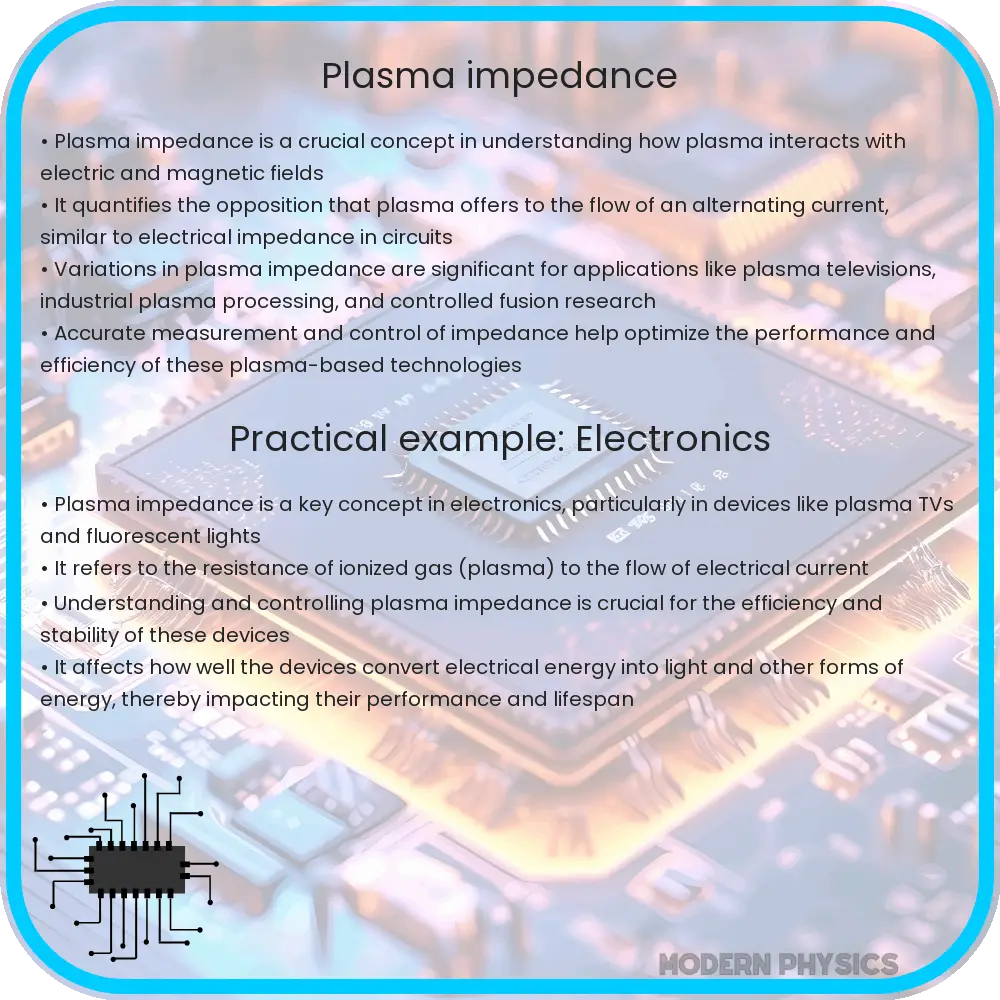Explore plasma impedance measurement techniques and analysis to understand plasma behavior, with applications in semiconductor manufacturing and aerospace industries.

Understanding Plasma Impedance
Plasma impedance plays a crucial role in various scientific and industrial processes, especially in plasma diagnostics and plasma processing techniques. It refers to the resistance that plasma offers to the flow of electric current. This property is vital for understanding plasma behavior, optimizing plasma-based processes, and ensuring the efficient operation of plasma devices. In this article, we will delve into the fundamentals of plasma impedance, its measurement techniques, and the analysis of these measurements.
Measurement Techniques
Measuring the impedance of plasma involves sophisticated techniques that provide insights into the plasma’s characteristics, such as density, temperature, and uniformity. The most common methods include:
- Langmuir Probe Technique: This method involves inserting a probe into the plasma and measuring the current-voltage (I-V) characteristics. The analysis of these characteristics allows the determination of plasma parameters, such as electron temperature and plasma density.
- Impedance Spectroscopy: This technique measures the plasma impedance over a range of frequencies. It is particularly useful for characterizing the plasma’s response to changes in frequency, which can reveal information about the plasma’s composition and dynamics.
- Optical Emission Spectroscopy (OES): Although not a direct method for measuring impedance, OES can complement impedance measurements by providing data on the plasma’s chemical composition and temperature, which influence its impedance.
Analysis of Plasma Impedance Measurements
Once plasma impedance measurements are obtained, the data must be analyzed to extract meaningful information about the plasma. The analysis involves:
- Electrical Modeling: Creating electrical models of the plasma can help in understanding how it behaves in response to electrical inputs. These models often incorporate elements like resistors, capacitors, and inductors to represent the plasma’s electrical characteristics.
- Data Fitting: By fitting the measured impedance data to theoretical models, one can estimate plasma parameters. This process requires sophisticated computational tools and a deep understanding of plasma physics.
- Correlation with Plasma Properties: The final step involves correlating the measured impedance with specific plasma properties, such as electron density and temperature, to draw conclusions about the plasma state or to optimize plasma-based processes.
Advanced Applications and Challenges
Plasma impedance measurement and analysis are not just academic exercises but have practical applications in industries ranging from semiconductor manufacturing to aerospace. For instance, in plasma etching processes used in semiconductor fabrication, monitoring plasma impedance can help in controlling the etching rate and uniformity, ensuring high-quality device production. Similarly, in the aerospace industry, understanding plasma behavior around spacecraft can be crucial for communications and navigational systems.
However, measuring and analyzing plasma impedance comes with its set of challenges. Plasma environments are highly dynamic and can vary significantly, making it difficult to obtain stable and reproducible measurements. Furthermore, the interaction between the measurement instruments and the plasma can introduce errors, necessitating careful calibration and data correction processes.
Future Directions
The field of plasma impedance measurement and analysis is continuously evolving, with research focused on developing more accurate, reliable, and non-invasive measurement techniques. Advances in computational methods for data analysis are also enhancing our ability to interpret complex impedance data, opening new avenues for plasma research and applications. As our understanding of plasma behavior improves, we can expect to see more sophisticated plasma-based technologies in various sectors, from electronics to energy generation.
Conclusion
Plasma impedance measurement and analysis are indispensable tools in the understanding and application of plasma science. By measuring how plasma resists electrical flow, scientists and engineers can gain insights into its properties and behaviors, leading to innovations in manufacturing, space exploration, and beyond. Despite the challenges, ongoing advancements in measurement techniques and analytical methods promise to unlock even deeper understanding and broader applications of plasma technologies. As we continue to explore the complexities of plasma, the potential for new discoveries and applications seems limitless, promising a future where plasma technologies play an even more integral role in our technological landscape.
